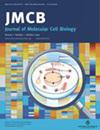Inhibition of GLUD1 mediated by LASP1 and SYVN1 contributes to hepatitis B virus X protein-induced hepatocarcinogenesis
IF 5.3
2区 生物学
Q2 CELL BIOLOGY
引用次数: 0
Abstract
Glutamate dehydrogenase 1 (GLUD1) is implicated in oncogenesis. However, little is known about the relationship between GLUD1 and hepatocellular carcinoma (HCC). In the present study, we demonstrated that the expression levels of GLUD1 significantly decreased in tumors, which was relevant to the poor prognosis of HCC. Functionally, GLUD1 silencing enhanced the growth and migration of HCC cells. Mechanistically, the upregulation of interleukin-32 through AKT activation contributes to GLUD1 silencing-facilitated hepatocarcinogenesis. The interaction between GLUD1 and AKT, as well as α-ketoglutarate regulated by GLUD1, can suppress AKT activation. In addition, LIM and SH3 protein 1 (LASP1) interacts with GLUD1 and induces GLUD1 degradation via the ubiquitin–proteasome pathway, which relies on the E3 ubiquitin ligase synoviolin (SYVN1), whose interaction with GLUD1 is enhanced by LASP1. In hepatitis B virus (HBV)-related HCC, the HBV X protein (HBX) can suppress GLUD1 with the participation of LASP1 and SYVN1. Collectively, our data suggest that GLUD1 silencing is significantly associated with HCC development, and LASP1 and SYVN1 mediate the inhibition of GLUD1 in HCC, especially in HBV-related tumors.LASP1 和 SYVN1 介导的 GLUD1 抑制作用有助于乙型肝炎病毒 X 蛋白诱导的肝癌发生
谷氨酸脱氢酶 1 (GLUD1) 与肿瘤发生有关。然而,人们对 GLUD1 与肝细胞癌(HCC)之间的关系知之甚少。在本研究中,我们发现 GLUD1 在肿瘤中的表达水平显著下降,这与 HCC 的不良预后有关。在功能上,沉默 GLUD1 能增强 HCC 细胞的生长和迁移。从机理上讲,白细胞介素-32通过AKT激活上调导致了GLUD1沉默促进肝癌的发生。GLUD1与AKT之间的相互作用以及GLUD1调控的α-酮戊二酸可抑制AKT的活化。此外,LIM 和 SH3 蛋白 1(LASP1)与 GLUD1 相互作用,并通过泛素-蛋白酶体途径诱导 GLUD1 降解,而泛素-蛋白酶体途径依赖于 E3 泛素连接酶 synoviolin(SYVN1),LASP1 可增强 SYVN1 与 GLUD1 的相互作用。在乙型肝炎病毒(HBV)相关的 HCC 中,HBV X 蛋白(HBX)可在 LASP1 和 SYVN1 的参与下抑制 GLUD1。总之,我们的数据表明,GLUD1 的沉默与 HCC 的发展密切相关,LASP1 和 SYVN1 在 HCC 中介导了对 GLUD1 的抑制,尤其是在 HBV 相关肿瘤中。
本文章由计算机程序翻译,如有差异,请以英文原文为准。
求助全文
约1分钟内获得全文
求助全文
来源期刊

Journal of Molecular Cell Biology
CELL BIOLOGY-
CiteScore
9.60
自引率
1.80%
发文量
1383
期刊介绍:
The Journal of Molecular Cell Biology ( JMCB ) is a full open access, peer-reviewed online journal interested in inter-disciplinary studies at the cross-sections between molecular and cell biology as well as other disciplines of life sciences. The broad scope of JMCB reflects the merging of these life science disciplines such as stem cell research, signaling, genetics, epigenetics, genomics, development, immunology, cancer biology, molecular pathogenesis, neuroscience, and systems biology. The journal will publish primary research papers with findings of unusual significance and broad scientific interest. Review articles, letters and commentary on timely issues are also welcome.
JMCB features an outstanding Editorial Board, which will serve as scientific advisors to the journal and provide strategic guidance for the development of the journal. By selecting only the best papers for publication, JMCB will provide a first rate publishing forum for scientists all over the world.
 求助内容:
求助内容: 应助结果提醒方式:
应助结果提醒方式:


